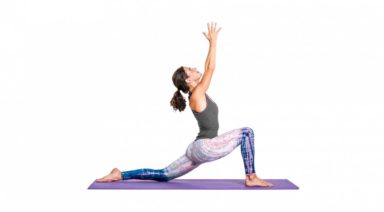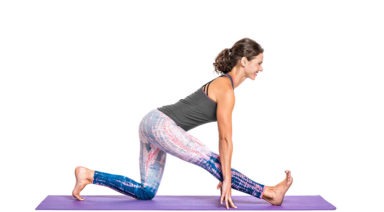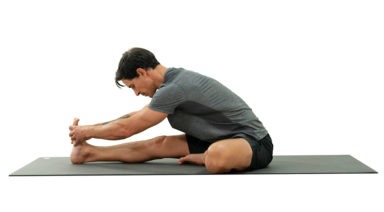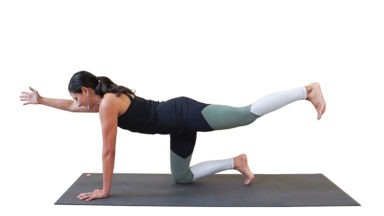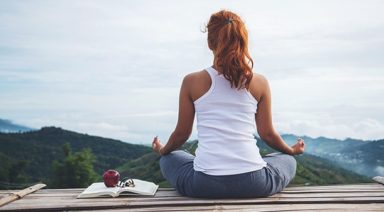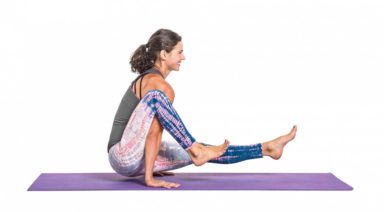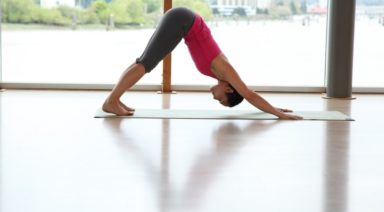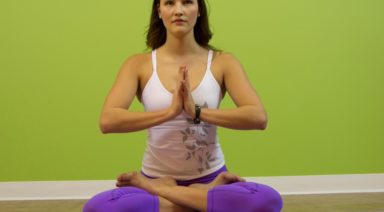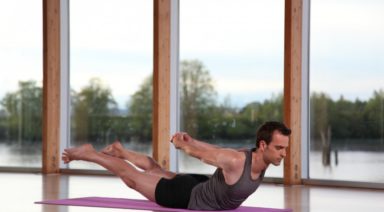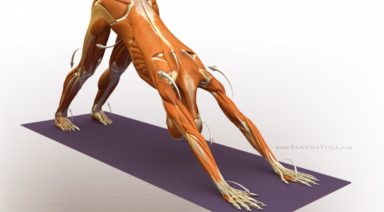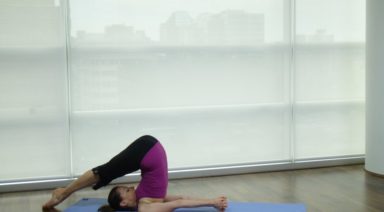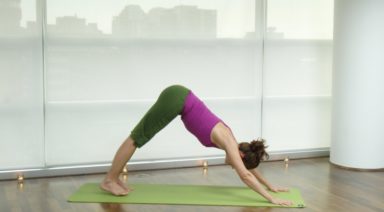Yoga, Crohn’s Disease and How I Got My Life Back

When people ask me how I got into yoga, I usually tell them I used it to rehab an injury. That’s true. After fracturing my lower back, yoga helped me regain strength and flexibility in my back and left leg, both of which were also affected by the fracture. I tell them how at peace yoga makes my mind and body feel. I explain how yoga makes me feel better in all aspects of my life. I tell them I believe yoga is great for the body but better for the soul, and when I teach, I rattle all off the bountiful mental, physical, emotional, and health benefits of each pose.
Sometimes I wonder whether people taking the class and therefore listening to the long list of benefits, wonder if I did an extensive Google search before hitting the mat. I wonder if they ponder whether I cite yoga’s healing powers because it sounds good or because a guru told me about them.
Living with Crohn’s Disease
What most people don’t know is that I’ve experienced yoga’s healing firsthand, and not just with an injury. What I never tell people―whether it be out of embarrassment or because it never comes up in conversation―is that I have a chronic illness. I have Crohn’s disease. To put it simply, Crohn’s is the inflammation of the gastrointestinal tract, which is every bit as glamorous as it sounds. Basically, my immune system attacks my gastrointestinal tract. Unfortunately, there isn’t a tremendous amount known about Crohn’s: Although it is an immune-related disease, it isn’t technically an autoimmune disorder. There is no known cure for Crohn’s.
I have always had a sensitive stomach, but around the age of fourteen or fifteen, my symptoms shifted. I determinedly ignored the fact that I was sick. Then, this past summer, debilitating pain resulted in me being hospitalized and receiving the official diagnosis.
Crohn’s isn’t fun to discuss and even less enjoyable to have. It isn’t a “trendy” illness or allergy (not that I believe any disorder or disease falls into that category); it is awkward and often unpredictable. It makes everyday activities, like going to work or going out, seem like monumental tasks. Aside from being almost perpetually sick to my stomach―I have learned to hide this well―Crohn’s comes with a whole host of sub-symptoms: I have episodes of exhaustion so intense that sometimes talking seems like work (challenging for someone like me, who loves good conversation), my joints ache, I’m usually unintentionally vitamin deficient. This has resulted in anemia, meaning my iron levels are low.
I’ve tried every elimination diet in the book. Half the time, I get so exhausted and frustrated trying to figure out what or when to eat, it feels easier to just not eat anything. So I usually don’t, which prompts all sorts of (warranted) questions about my dubious eating habits. The worst part is the nearly all-consuming anxiety that stems from never feeling in control. Over the summer, I was embarrassed to leave my dorm. I looked sick: Hair coming out in handfuls, pale, dry skin. It didn’t look pretty and felt even worse.
How Yoga Gave Me My Life Back
So how in the world does a person like this do yoga, let alone anything else? Honestly, I believe that yoga makes it possible.
As a former ballet dancer, I practiced yoga occasionally, using it as a training supplement, but two years ago, as a freshman in college, I really fell in love with it. Caught up in feeling lonely and sick and sorry for myself, I stumbled into a hot yoga class.
I haven’t been the same since.
I emerged feeling rejuvenated and alive in a way I hadn’t in a long time. I felt clear-headed and alert, but calm. I wasn’t anxious about my stomach or whatever was happening in my life at that moment. Yoga stripped away the layers of illness, insecurity, and panic, and built them back up with peace. Peace, I found, is the most fulfilling substance of all.
I don’t use prescription medication to treat Crohn’s. I take over-the-counter meds on an as-needed basis. I’ve tried to restore my body to as natural a state as possible, and while I believe yoga has certainly helped with the physical symptoms of the illness, what I think it really changed was my mind.
What You Think You Become
“What you think, you become” is not an overstatement. If you think frantic, depressing thoughts, they will eventually manifest themselves physically. When your entire body feels broken, it is all too easy to fall into a “what is wrong with me” mindset.
Yoga doesn’t try to answer the question “What is wrong with me?” Instead, yoga demonstrates all the many, many things that are right with you. It shows you yourself at your purest, your freest, your lightest. That version of you is the truth. We all have things that are less than ideal, whether it be a difficult situation, an illness, poor body image. But what we forget is that we all possess things that are inexplicably right; that are noble and wonderful and worthy. Yoga made it possible for me to see these things in myself.
I actually credit Crohn’s with a lot. Because of this illness, I am more patient and understanding, I am more in tune with my body and I try to focus on what is right instead of the wrong.
I have a long way to go and a lot to work on, but every time I stand on a yoga mat, I feel myself getting better. I want people to know that whatever you believe is wrong with you, there are dozens of things that are right with you, and the world deserves to see them. You owe it to yourself. Every time you feel too sick or too sad or too wrong, please step onto that mat, close your eyes and let yoga heal every part of you.
It is the greatest cure.
Yoga and Lymphatic Circulation
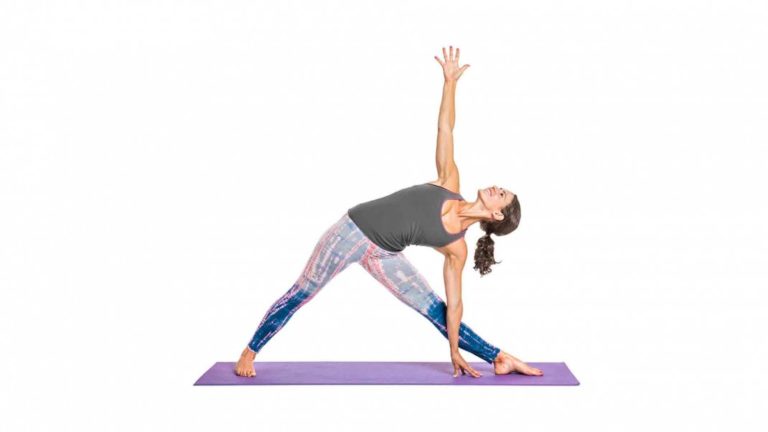
According to Live Science, “the lymphatic system is a network of tissues and organs that help rid the body of toxins, waste and other unwanted materials,” including a fluid that contains white blood cells that help fight infections. You are probably most familiar with the lymph nodes in the lymphatic system, but the lymphatic system travels through your body from your tonsils and adenoids to your spleen. There are lymph nodes located around vital organs like your heart and lungs and in your armpit and near your groin area.
This internal system produces the antibodies necessary to kill bad actors in your body and prevent an infection in one part of your body from spreading to another. If your lymphatic system stops working, fluids begin to build up in your body and several different conditions can occur, including infections, swollen glands, blockages, autoimmune disorders, certain types of cancer, and lymphedema. Since the lymphatic system travels through so many parts of your body, it is crucial that we keep it healthy.
Yoga and Lymphatic Circulation
As you may know, yoga is one of the best practices for strengthening the body and reducing stress. What you might not realize is the role yoga plays in increasing circulation throughout the body. Increasing circulation helps allow the lymphatic system to transport good stuff and filter out the bad, which means that any amount or type of yoga will improve your lymphatic system.
Think of the lymphatic system as a super highway that filters toxins and circulates antibodies throughout your body. This system is critical to getting you better when you are sick. Moreover, unlike the way blood travels through the body, the heart does not control the pumping of the lymphatic system. Instead, the system moves by muscular contractions. Even more reason to strengthen your muscles.
One aspect of yoga that has dramatic effects on the lymphatic system is pranayama. Pranayama is the practice of deep, controlled breathing. By practicing these deep breaths, you are able to better circulate good fluids throughout your body and remove bad toxins.
Routine Maintenance of the Lymphatic System
Yoga poses that invert the legs and allow gravity to act on the lymphatic channels are particularly helpful to keeping the system flowing and functioning optimally. In addition to these type of poses, any dynamic postures that build heat and keep the body moving are also beneficial. For these yoga postures to be the most productive, focus more on your breath than perfecting the postures. Below are some sample poses to get you started:
Downward Facing Dog Adho Mukha Svanasana
A classic pose, but did you know that it builds strength throughout the body and improves the functioning of your immune system? To attempt this pose, firmly plant your feet at the bottom of your mat, then place your hands at the top of your mat so that your body forms an upside V. If you are already under-the-weather when you try this, have a block nearby to rest your head.
Cat-Cow – Bitilasana
By far my favorite yoga pose, Cat-Cow gets everything flowing with only moderate effort. First, go into Tabletop pose (your hands and knees firmly planted on your mat, with your toes pointed behind you). Now arch your back like a cat, letting your gaze fall to the floor in between your outstretched hands. Next, curve your spine the other way your body forms a U the other way. Your head should face towards the ceiling. Do this at least two dozen times, then rest in Child’s Pose to finish.
Sun Salutations are a great way to build strength and increase circulation throughout the body.
Standing Forward Bend – Uttanasana
Gather two blocks before planting your feet firmly on the back of your mat. Spread your feet a little wider than hip-widths apart and then rest your head on top of the bricks. Stay here for several deep breaths.
Other Practices to Improve Lymphatic System
- Water, water and more water. Drinking plenty of fluids is far and away the best method for improving and maintaining all of the systems in your body.
- Go for a brisk walk. Keep your arms and legs moving and walk faster than normal. This will jumpstart your lymphatic system and get all the good stuff flowing.
- In addition to the restorative yoga and low-intensity positions, there are other types of yoga for when you are sick, including Yin Yoga specially tailored to the winter cold and flu season.
Poses for a Weak Lymphatic System
I’ll be honest, I am the worst when I’m sick. Rarely do I feel like anything more than sitting on the sofa and watching reruns, much less partaking in a full yoga session. But, if you are able to get yourself up and moving, there are some low-intensity postures that can help a cold run its course faster so you can get back to feeling like yourself again.
A cold or allergies means that your lymphatic system is blocked. In addition to whatever your doctor recommends, include these chest-opening yoga postures into your get-well-soon regime.
Start by dimming the lights in the room and have extra blankets and blocks nearby, as the last thing you want to do is over-exert yourself. Feel free to turn any of these poses into supported poses. These postures should be done more like restorative yoga.
Bridge Pose is a great chest opener, but if you are feeling under-the-weather try the Supported Bridge Pose – Setu Bandha Sarvangasana – it is much easier on achy joints. Lie down on your mat with your palms down. Bending your knees, pull your heels towards your fingertips. Then push down with your hands to lift your hips up, while you slide a brick lengthwise under your torso. Lastly, pull your shoulder blades in towards each other as much as possible. You should feel your chest opening. Close your eyes and relax while gravity does the work for you.
Bow Pose – Dhanurasana
Traditionally best for strengthening your abdomen, but also stimulates your thymus gland and rejuvenates the parts of the lymphatic system closest to your chest. Try this pose when you have a lot of post-nasal drip flowing into your chest. Begin face-down on your mat – extra blankets are suggested for this one. Separate your legs on the mat about hips-width. Take several deep breaths. Then, as your release your breath, grab hold of your ankles so that your body is shaped like an archer’s bow. Continue to lift your thighs off the mat until you exhale and lower yourself back down to the mat. Repeat two to three times.
Cobra Pose – Bhujangasana
Often part of Sun Salutations, Cobra Pose is another ideal chest opener. Lie face-down on your mat and take several deep breaths. Place your hands, fingers spread wide, on the mat under your shoulders. Press your body into your mat and as you inhale, begin to straighten your arms. You will rise off the mat, except your hands and the tops of your feet. Keep your body tightened. Bend your head back slightly so your gaze moves from in front of you towards the ceiling. Hold this for your full breath, then come back to your mat and exhale. Repeat for a minute.
Extended Triangle Pose – Utthita Trikonasana (as pictured above)
Spread your legs wide so you take up the entire mat lengthwise. Your left foot should be pointed towards the front of the room; your back or right foot turned perpendicular to your front foot. Keep your abdomen tucked in. Put your left hand on your left ankle and hold on. Then, twist your right arm towards the ceiling and hold for three deep breaths. Now switch arms and hold for another three breaths.
Legs Up the Wall – Viparita Karani
Last, but not least, this pose lets gravity do the work so you can relax. Move your mat up against the wall at place a blanket or two on top. Lie on top of the blankets with your bottom against the wall and your legs going up the wall. You should form an “L.” Stretch out your arms so your torso and arms form a “T.” Then, close your eyes and lie there for at least fifteen minutes. I don’t know about you, but – sick or not sick – I could do this one all day!







